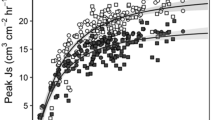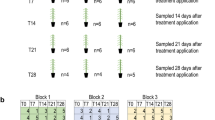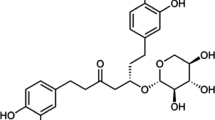Summary
The concentration of phenols, procyanidins, and protein in pine foliage was determined at two and eight weeks following mechanical defoliation of 0, 25, 50, and 75%. Changes in both mature and immature ponderosa pine, Pinus ponderosa Dougl. ex Laws, foliage were monitored. The lowest level of defoliation (25%) produced the largest increase in phenols; 75% defoliation caused the largest increase in procyanidins. The number of phenolic compounds in mature foliage doubled following 25% defoliation. Maximum protein production also occurred at moderate defaliation levels. Mechanical defoliation had a significant effect on the production of all compounds tested. The implications of these results for induced resistance research are discussed.
Similar content being viewed by others
References
Audette RCS, Blunden G, Steele JW, Wong CSC (1966) Thin-layer chromatography of phenolic glycosides and it's use as a screening procedure for the genus Salix. J Chromatogr 25:367–372
Bernays EA, Woodhead S (1982) Plant phenols utilized as nutrient by a phytophagous insect. Science 216:201–202
Bernays EA, Chamberlain DJ, Woodhead S (1983) Phenols as nutrients for a phytophagous insect, Anacridium melanorhodon. J Insect Physiol 29(6):535–539
Bradford MM (1976) A rapid and sensitive method for the quantitation of microgram quantities of protein utilizing the principle of protein-dye binding. Analytical Biochemistry 72:248–254
Feeny PP (1976) Plant apparency and plant defense. In: Biochemical Interactions Between Plants and Insects. Wallace J, Mansell R (eds) Recent Advances in Phytochemistry 10:1–40
Harborne JB (1973) Phytochemical Methods. Chapman-Hall, London, pp 34–38
Levin DA (1971) Plant phenolics: an ecological perspective. The American Naturalist 105 (942):157–181
Mattson WJ Jr (1980) Herbivory in relation to plant nitrogen content. Annual Review of Ecology and systematics 11:119–161
Moore RF (1983) Effect of dietary gossypol on the boll weevil (Coleoptera: Curculionidae). J Economic Entomol 76(4):696–699
Nichols JO (1968) Oak mortality in Pennsylvania: A ten year study. Journal of Forestry September: 681–694
Price MS, VanScoyoc S, Butler LG (1978) A critical evaluation of the vanillin reaction as an assay for tannin in sorghum grain. J Agricultural Chemistry 26(5):1214–1218
Rhoades DF, Cates RC (1976) Toward a general theory of plant and antiherbivore chemistry. In: Biochemical Interactions Between Plants and Insects. Wallace J, Mansell R (eds) Recent Advances in Phytochemistry 10:168–213
Ribereau-Gayon P (1972) Plant Phenolics. Hafner, New York, p 47
Schultz DE, Allen DC (1977) Characteristics of site with high black cherry mortality due to bark beetles following defoliation by Hydria prunivorata (Lepidoptera: Geometridae). Environmental Entomology 6:77–81
Schultz JD, Baldwin IT (1982) Oak leaf quality declines in response to defoliation by gypsy moth larvae. Science 217:149–151
Zucker WV (1983) Tannis: Does structure determine function: an ecological perspective. American Naturalist 121:335–365
Author information
Authors and Affiliations
Rights and permissions
About this article
Cite this article
Wagner, M.R., Evans, P.D. Defoliation increases nutritional quality and allelochemics of pine seedlings. Oecologia 67, 235–237 (1985). https://doi.org/10.1007/BF00384291
Received:
Issue Date:
DOI: https://doi.org/10.1007/BF00384291




